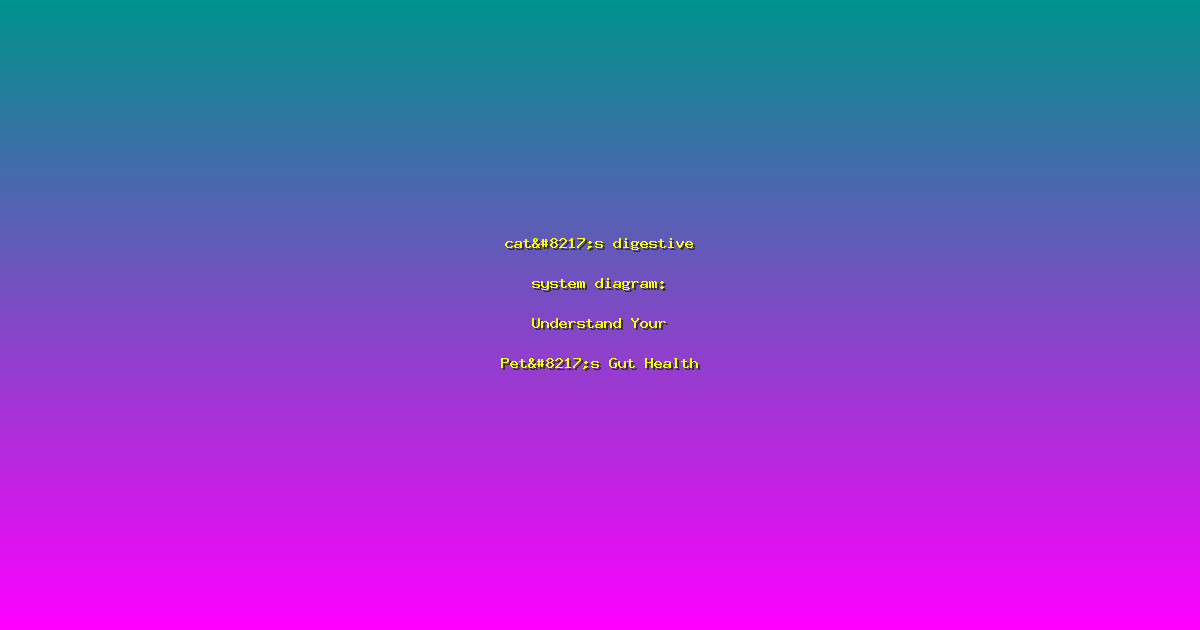cat’s digestive system diagram: Understand Your Pet’s Gut Health
Have you ever wondered how your feline friend processes their food? Understanding your cat’s digestive system can be a game-changer in ensuring their overall health and well-being. The cat’s digestive system diagram is a powerful tool that can help you identify potential issues and make informed decisions about your pet’s diet and care. By delving into the intricacies of your cat’s gut, you can ensure they live a long, healthy life. Let’s explore the fascinating world of your cat’s digestive system.
The Anatomy of a Cat’s Digestive System
The cat’s digestive system is a complex network of organs that work together to break down food, absorb nutrients, and eliminate waste. From the mouth to the anus, each part plays a crucial role in maintaining your cat’s health. Understanding the anatomy can help you recognize signs of digestive issues and take proactive steps to address them.
- Mouth and Esophagus: The process begins in the mouth, where your cat chews and swallows food. The esophagus then transports the food to the stomach.
- Stomach: The stomach is where the real work begins. It secretes acids and enzymes to break down food into smaller particles, making it easier for the body to absorb nutrients.
- Small and Large Intestines: The small intestine is responsible for absorbing most of the nutrients, while the large intestine (colon) absorbs water and forms the stool.
Common Digestive Issues in Cats
Despite the efficiency of the cat’s digestive system, various issues can arise, leading to discomfort and health problems. By familiarizing yourself with the cat’s digestive system diagram, you can better understand and address these issues.
- Diarrhea: Diarrhea is a common issue that can be caused by dietary changes, infections, or parasites. It’s important to monitor your cat’s stool consistency and seek veterinary advice if it persists.
- Vomiting: Vomiting can be a sign of a more serious issue, such as hairballs, ingestion of foreign objects, or underlying health conditions. Regular grooming and a balanced diet can help prevent these problems.
- Constipation: Constipation can be caused by dehydration, lack of fiber in the diet, or even stress. Ensuring your cat has access to clean water and a balanced diet can help prevent this issue.
How to Maintain a Healthy Digestive System in Cats
Maintaining a healthy digestive system is crucial for your cat’s overall well-being. By following these tips, you can help ensure your feline friend stays healthy and happy.
- Proper Diet: A balanced diet rich in protein and essential nutrients is key to a healthy digestive system. Consult with your veterinarian to determine the best diet for your cat.
- Regular Vet Check-ups: Regular check-ups can help identify and address any potential issues before they become serious. Your vet can provide valuable insights into your cat’s digestive health.
- Hydration: Ensuring your cat stays hydrated is essential for proper digestion. Encourage your cat to drink water by providing fresh, clean water at all times.
Frequently Asked Questions
What are the signs of digestive issues in cats?
Signs of digestive issues in cats can include vomiting, diarrhea, constipation, loss of appetite, and lethargy. If you notice any of these symptoms, it’s important to consult your veterinarian for a proper diagnosis and treatment plan.
How can I prevent hairballs in my cat?
Hairballs are a common issue in cats, especially long-haired breeds. Regular grooming, such as brushing, can help reduce the amount of hair your cat ingests. Additionally, feeding your cat a diet rich in fiber can help move hair through the digestive system more easily.
What should I do if my cat is constipated?
If your cat is constipated, it’s important to address the issue promptly. Increase your cat’s water intake, provide a high-fiber diet, and consult your veterinarian for further advice. In severe cases, your vet may prescribe medication or recommend a change in diet.
Can stress affect my cat’s digestive system?
Yes, stress can significantly impact your cat’s digestive system. Environmental changes, such as moving to a new home or the introduction of a new pet, can cause stress and lead to digestive issues. Creating a calm and comfortable environment for your cat can help alleviate stress and promote a healthy digestive system.
What are some common digestive supplements for cats?
Common digestive supplements for cats include probiotics, fiber supplements, and digestive enzymes. These can help support your cat’s gut health and improve digestion. However, it’s important to consult your veterinarian before starting any new supplements.
Conclusion
Understanding the cat’s digestive system diagram is essential for maintaining your feline friend’s health. By familiarizing yourself with the anatomy, recognizing common issues, and taking proactive steps to maintain a healthy digestive system, you can ensure your cat lives a long, happy, and healthy life. Remember, regular check-ups and a balanced diet are key to keeping your cat’s digestive system in top condition. Take the first step today and consult your veterinarian to learn more about your cat’s digestive health.

